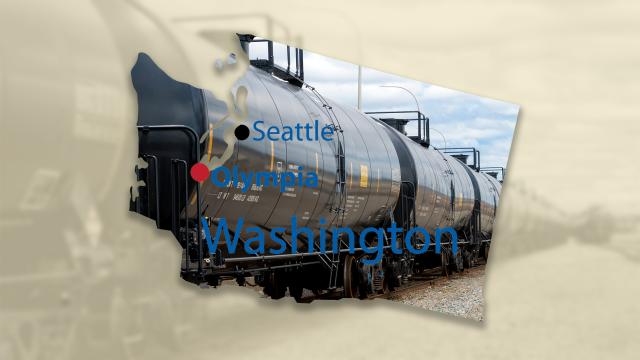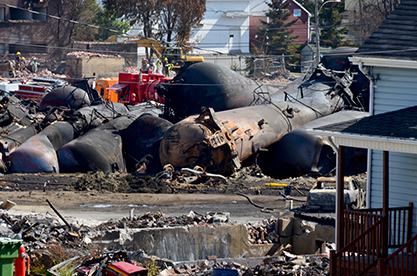
(Source: Hart Energy, Shutterstock)
Test yourself (true or false):
- The Bakken Shale, in a region that is relatively new to oil production, is more reliant on transport options such as rail and trucks to move product to market than most other producing areas.
- The chemical composition of Bakken crude oil is more volatile than crude from other regions and therefore more likely to ignite and cause more damage in the event of a train derailment.
- Lowering the vapor pressure of the crude during transportation can reduce the severity of a tragic accident.
Congratulations if you answered “true” to No. 1 and “c’mon, where’s the science to back that up?” to Nos. 2 and 3.Treat yourself to a bowl of popcorn and an evening watching “Fargo.”
But while you’re watching the movie, be aware that proposed legislation in Washington State would lower the allowed vapor pressure of crude oil from the Bakken traveling by rail to below 9 pounds per square inch, a measure that could block an important market for the shale play’s oil producers and trigger a range of transport issues for numerous petrochemicals.
That’s without, to this point, a firm scientific foundation to back it up.
“To date, there is a dearth of scientific data that conclusively correlates higher vapor pressure to the severity of consequences of a transportation incident,” Rachel Meidl, a fellow at Rice University’s Baker Institute and former official at the U.S. Department of Transportation’s (DOT) Pipeline and Hazardous Materials Safety Administration (PHMSA), told Hart Energy.
“Although Bakken and other light crude are high in light-end paraffinic range hydrocarbons, when classified and transported in the appropriate packaging system, Bakken crude is as safe to transport as other crudes,” Meidl said. “Furthermore, Bakken crude does not exhibit appreciable differences when compared to other crude oil or flammable liquids that are authorized for rail transport.”
The American Fuel & Petrochemical Manufacturers (AFPM), in an October 2018 report for the North Dakota Industrial Commission, dismissed the prospect of lowering vapor pressure to reduce risk. Ignition events are caused, said AFPM, by the proximity of a flammable liquid to heat above the liquid’s flashpoint, not by any particular level of vapor pressure. Safety can be enhanced, the report said, on the part of the railroads.
“Improvements in track integrity would significantly reduce both the frequency and consequences of derailments,” AFPM said.
At the moment, the lack of conclusive science has not precluded a struggle over the direction that safety regulations should take, particularly in Washington’s capital of Olympia.
“Washington State, in 2017, joined with attorney generals from five other states to request that PHMSA (USDOT) adopt a federal standard of 9 pounds per square inch,” Aaron Wasser, spokesman for Washington Senate Majority Leader Sen. Andy Billig, told Hart Energy. “PHMSA did not act, so we are taking action at the state level.”
Wasser was referring to a letter to Transportation Secretary Elaine Chao and PHMSA Executive Director Howard McMillan from the attorneys general of New York, California, Illinois, Maryland, Maine and Washington. In it, the six issued a response to a PHMSA advance notice of proposed rulemaking (ANPRM) that was issued two days before the inauguration of President Donald Trump in January 2017. Soon after, the ANPRM was tabled by the Trump administration.
The ANPRM states that it is “based on the premise that limiting the vapor pressure, as measured by RVP [Reid vapor pressure, a common measure of the volatility of petroleum products], of crude oil in rail transport below 9.0 psi will reduce the risk of death or damage from fire or explosion in the event of an accident.”
The vapor pressure of the Bakken crude involved in the Lac-Mégantic, Quebec derailment in July 2013 was between 9 psi and 9.5 psi. But PHMSA stated in its proposal that science was needed to support any eventual rule.

That science is expected this spring in the form of a multi-year study on crude oil characteristics mandated by Congress and conducted by Sandia National Laboratories.
“It remains to be seen how and to what degree this study will contribute to better understanding crude oil characterization and behavior in accident scenarios and if PHMSA’s decisions will be informed by the learnings of the Sandia study,” Meidl said. “Should PHSMA decide to pursue a national vapor pressure threshold, they will likely postpone action until the close of the study.”
Lawmakers in Washington State, however, were not willing to wait. The bill mandating lower vapor pressure was passed by the state Senate on March 4 but has not yet made it to the floor of the House.
“This also sets a dangerous precedent [if it passes],” Meidl said. “If vapor pressure is, in fact, the most significant factor in determining safe transport in hazardous materials transportation, should vapor pressure thresholds be considered for all DOT Class 3 flammable liquids? Doing so would cast a wide net on an entire universe of materials and fundamentally alter how all commodities and wastes are classified, packaged and transported.”
Class 3 liquids include ethanol, gasoline blend stocks, heavy naphthas, iso-octane, benzene toluene and xylene isomers.
The bill’s passage as it stands is not a sure thing. During executive session of the State House Environment & Energy Committee on April 1, concerns were raised about job losses at crude terminals and the loss of the economic benefits of U.S.-origin crude oil.
“I do consider this bill to be a work in progress,” Committee Chairman Joe Fitzgibbon, the bill’s sponsor in the house, conceded. “I think that we still have a lot more information to absorb around vapor pressure and the right ways to ensure that safety around our communities that crude oil moves through by rail.”
Producers in North Dakota have sought to set the record straight.
“We had four different individuals that went out to Washington State to testify at a hearing to essentially give scientific data on why 9 psi vapor pressure does not improve safety,” Kari Cutting, vice president of the North Dakota Petroleum Council, told Hart Energy. “I think that we made a pretty good case that we should wait for the Sandia study to be finalized and make sure that vapor pressure really will improve safety.”
Should the bill pass the Washington State Legislature, the reverberations will extend beyond the impact to Bakken producers, who will pursue other markets, Cutting said. Washington’s refineries will need to find feedstock elsewhere. Crude from other shale regions may very well have vapor pressure that is equal to or higher than the 9 psi level. Another option is to turn away from domestically produced crude and import foreign oil by tanker vessel, which would add to greenhouse gas emissions in the area.
Or, simply wait for the Sandia study to be published, likely in the next few weeks, and base new standards on its conclusions.
“It’s important,” Cutting said, “that good legislation be based on science.”
Recommended Reading
Venture Global LNG Pares IPO Hopes by 15% to $2.2B
2025-01-22 - LNG exporter Venture Global nearly halved the price per share, while increasing the number of shares it expects to offer.
Expand Appoints Dan Turco to EVP of Marketing, Commercial
2025-02-13 - Expand Energy Corp. has appointed industry veteran Dan Turco as executive vice president of marketing and commercial.
Venture Global Targets $110B in Massive IPO
2025-01-13 - Venture Global is expected to pitch its IPO to investors by Jan. 17 to rival the largest energy IPOs on record.
Kissler: Gas Producers Should Still Hedge on Price
2025-03-27 - Recent price jumps and rising demand don’t negate the need to protect against future drops.
Argent LNG, Baker Hughes Sign Agreement for Louisiana Project
2025-02-03 - Baker Hughes will provide infrastructure for Argent LNG’s 24 mtpa Louisiana project, which is slated to start construction in 2026.
Comments
Add new comment
This conversation is moderated according to Hart Energy community rules. Please read the rules before joining the discussion. If you’re experiencing any technical problems, please contact our customer care team.






